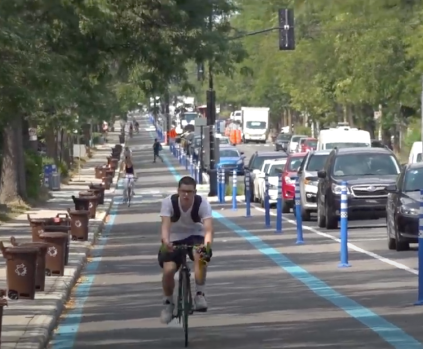Last month, I journeyed to Montréal, a city I have visited many times in the last three decades, to see how much progress it has made in reining in the car culture, creating more livable communities, encouraging cycling, making roadways safer and, most important, bringing back freedom to inhabitants long oppressed by car drivers.
The changes are amazing — and they are the subject of two new Streetfilms, my 1,000th and 1,001st of my career. The first one is about open streets. The other is about cycling. Both will make New Yorkers drool … or book tickets.
Of course, Montréal has fewer open streets than New York City does, but the open streets in the Paris of North America are much better. Montréal’s 13 open streets are much longer and operate almost entirely car-free — car-free, meaning no parking, either! — 24 hours a day, all summer long.
“It’s about making the city accessible for everyone,” Montréal’s mayor Valérie Plante told me. “There has to be more room for cyclists and pedestrians, and arts and parklets.”
On Montréal’s open streets, you don’t just see people walking or biking as you see in New York, but also art installations, benches, bioswales, swings (with cupholders!), play areas for kids and bollards to keep out the cars.
Bollards to keep out the cars.
“It just brings so much joy and fun and, of course, safe spaces for our kids,” Plante added.
And local business owners confirm that pedestrianized zones bring in more money for struggling merchants.
A 1.5-mile stretch of Mont Royal Avenue is fully pedestrianized, including some side streets. That’s about the same length as New York’s best open street — 34th Avenue in Jackson Heights — but in New York, the open street is still filled with parked cars and only open between 8 a.m. and 8 p.m., limiting what residents can do, how many can do it and how long they can do it for. There’s a movement to make the open street permanent and 24 hours — a position supported by incoming mayor Eric Adams — but opponents in the neighborhood want the open street reduced or even eliminated.
Montréal proves that the real solution should be to double-down on open streets. Barricades keep the cars out — and don’t require a massive volunteer effort. And instead of dismissing older adults’ worries about getting around, the city provides transportation (via pedicabs) for them.
The other film looks at Montreal’s latest bike infrastructure — whose success can be summed up in two comments from residents:
“It fun to feel you’re in a culture that encourages cycling,” one woman told me.
“To walk out onto my street and be safe is just incredible,” said another woman, who added that she had not felt the same feeling in other cities in which she had lived.
The city’s bike network is called REV, which is apparently a play on words because “rêve” means “dream” in French, but for us English speakers, you don’t need a pun to enjoy the “Express Bike Network”: the bike lanes are wider, safer and more connected in Montreal than they are in New York.
And here’s why that matters: “I would never send my kid biking through the city if the REV didn’t exist,” said bike advocate Severine Le Page.
See it all below:
One final note for all us nerds: Make sure you check out the appearance of former Streetsblog contributor Steven Miller in the Montreal open streets video.
Editor’s note: These two films represent the 1,000th and 1,001st mini-documentaries by Streetfilms Director Clarence Eckerson Jr., who has been making these movies since the mid-2000s. It is time for the Academy of Motion Picture Arts and Sciences to consider Eckerson for a lifetime Oscar. And if they won’t, we will. For the highlights of Eckerson’s long career in fighting to end discrimination against cyclists and pedestrians, and to break the car culture, click here.





